
Volume 6, Issue 1 - Jan/Feb 1999
Published: January 1, 1999
Ferrari 333 SPs Finish 2nd, 3rd, 4th, and 8th at 24 Hours of Daytona
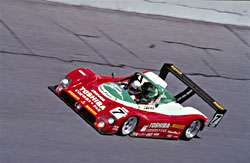
daytona - daytona pit stop foils ferrari -
"gimme a brake!
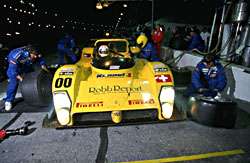 in
case you missed it, the 1999 rolex 24 hours of daytona was won by the dyson racing team
for the second time in three years. ln a classic ford versus ferrari battle, the dyson
team endured to become victorious after spending the night switching places with the doyle
- risi ferrari. in the early morning hours, the dyson riley & scott mark iii took over
the lead for good with butch leitzinger at the wheel.
in
case you missed it, the 1999 rolex 24 hours of daytona was won by the dyson racing team
for the second time in three years. ln a classic ford versus ferrari battle, the dyson
team endured to become victorious after spending the night switching places with the doyle
- risi ferrari. in the early morning hours, the dyson riley & scott mark iii took over
the lead for good with butch leitzinger at the wheel.
the team of leitzinger, rob dyson, elliot forbes-robinson and andy wallace kept out of
trouble in a race with heavy traffic that had a record 83 entries. as torrential rainfall
began to fall and high winds moved in from the ocean on sunday morning, the high downforce
of the r&s and the skillful driving of the talented dyson driver lineup allowed the
dyson #20 to remain in the lead through the nasty winter storm. the correct selection of
tires by team manager pat smith ensured the victory as the second place ferrari lost vital
time in the closing hours on intermediate wet tires.
but racing luck in the form of an early-sunday morning brake problem cost the doyle-risi
ferrari 333 sp team 3 laps in the pits. the margin between them and the winning dyson car
was two laps.
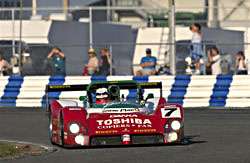 from the
start, the battle for position at the front of the can-am field was hotly contested
between the doyle-risi and doran-matthews ferraris (papis/johansson driving). team dyson
dueled with doyle-risi's wayne taylor, allan mcnish, didier de radigues and massimillano
angelelli throughout saturday night and into sunday, with neither car extending to more
than a two-lap lead over the other.
from the
start, the battle for position at the front of the can-am field was hotly contested
between the doyle-risi and doran-matthews ferraris (papis/johansson driving). team dyson
dueled with doyle-risi's wayne taylor, allan mcnish, didier de radigues and massimillano
angelelli throughout saturday night and into sunday, with neither car extending to more
than a two-lap lead over the other.
"a brake problem this morning cost us the race", said mcnish. "it cost us
three laps, and we could never make them up. i'm happy for the team. i'm sorry we didn't
win, but it was a good result."
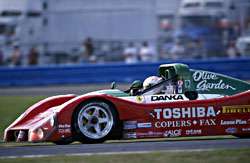 ferrari
330 sp's had a generally good day, placing 3rd overall (matthews/johannson/papis/vasser),
4th overall, (calderari/ bryner/zadra/rosenblad) and 8th overall, (lienhard/theys/
baldi/luyendyk).
ferrari
330 sp's had a generally good day, placing 3rd overall (matthews/johannson/papis/vasser),
4th overall, (calderari/ bryner/zadra/rosenblad) and 8th overall, (lienhard/theys/
baldi/luyendyk).
President's Corner
by: wally clark
happy 1999 to you all!
as this newsletter reaches you, i am preparing to attend the fca national board of
directors meeting as your regional director. on the agenda is a proposal to make the fca
annual dues $115. for all regions. this will allow $35. per member to be returned to the
region to help with funding regional events. since the southwest region is already at this
level of dues, this is not a change for us.
the fca is strong nationally, with over 4300 members and our region has over 450 members.
as we move into the year 2000, the club is looking for leadership to take us into the
millennium. if you would like to get involved, please let me or let another board member
know.
we have some interesting events coming up in 1999, events that i hope will appeal to all
members. one event is the hearst castle ride and drive organized by the pacific region. we
have been invited to participate with their members, which is always a fun event. see the
flyer in this issue for sign up information. the 2002 annual meet committee has decided
the dates of the event will be the week of memorial day weekend in may 2002. the
headquarters will be the century plaza hotel and the theme will be early ferrari racing.
don't forget the 1999 fca annual meet which is in atlanta at the chateau elan winery and
resort. see the fca national monthly news bulletin for a sign up form or call (770)
217-2500.
Brakes, Power Assist - Part 1
by: bill pound
power assisted brakes have been with us now for many years. vacuum is taken from the
intake manifold and used to boost the hydraulic pressure applied by the driver via a large
rubber diaphragm in the brake booster. in most manufacturers applications, manifold vacuum
is taken from the large plenum chamber in the intake manifold between the engine and the
butterfly or butterflies in the carburetors or injectors, this is an ideal arrangement, as
long as the motor is running there is usually up to 23 inches (hg) of vacuum to operate
the brakes. all the cylinders of the engine feed from this chamber enabling the system to
re generate vacuum quickly.
ferrari, over the years beginning with the 250, but continuing on through the evolution
of the 2 cam motor right up to the 365, has utilized only vacuum from the rear carburetor
of the engine to generate vacuum for power assist to the braking system. for example, most
of the 2 cam 3 carb engines use only the rear carb manifold to generate vacuum, this
manifold serves the rear 2 cylinders on each side (cyl # 5-6-7-8 ) the amount of vacuum
generated is sufficient to stop the car under normal driving conditions provided one does
not pump the pedal excessively. on idle when the engine speed is insufficient to
regenerate vacuum quickly, three or four fast applications of the brake will usually
result in a very hard pedal with very little stopping ability. basically, once all the
boost vacuum is gone, all that is left is your leg strength.
this was not a problem, rather something one needed to get used to. when the 6 carb
engines were introduced, particularly the 275 4 cam which had rather radical valve timing,
(any increase in camshaft duration results in a decrease in manifold vacuum) on these cars
the rear carb manifold only draws vacuum from 2 cylinders so there is almost no reserve.
in addition, due to the small displacement of the cylinders ( 2 x 275 = 550 cc) they are
unable to regenerate vacuum quickly. on idle, two brake applications can exhaust the
vacuum supply on a 275 4 cam. this problem exists to some degree on all pre-fuel injected
308's and dino's, both of which pull vacuum only from the left rear intake port. some
cars, 365gtc/4, daytona, 512bb, 400 series were fitted with a small vacuum pump driven
usually directly off the end of one camshaft to assist vacuum at low engine speed brake
applications.
adapting one of these pumps is no easy matter, impossible on some cars, but there are a
couple of solutions which will work very well on all 2 cam, and 275 4 cam motors. one
requires removal of all the carbs and intake manifolds, the manifolds need to be jigged
(accurately set up) so that a .500" hole can be bored through each of them, passing
through the plenum chamber under the carb. aluminum tubes are accurately machined to join
all the plenums together so that all 12 cylinders are now supplying vacuum to the power
brake or servo unit. the tubes must be machined to the correct diameter on the ends and
the correct length, "o" rings are fitted to each end to prevent leaks. no vacuum
leak can be tolerated anywhere in the intake system. any amount of leakage into the intake
system whether by leaks or improperly closing or worn throttle shafts, particularly on 6
carb motors will result in the inability to get idle speed under 1500 rpm, that is simply
because with all those carbs, each one does not need to "bleed" much air past
the butterflies to give the motor enough air to want to idle at 1500 rpm or above.
the other solution is to mount a reservoir somewhere in the car to hold additional
vacuum. this requires the use of a one way check valve (from a 308) so that the reservoir
will always hold vacuum and not let it escape back into the intake manifold when the motor
is turned off. old fire extinguisher bottles are sometimes useful for this purpose
Ferrari?s First Four-Cylinder Sports Cars
reprinted by permission of the ferrari market letter
roush publications, inc.
 legend has it
that is was the exploits of a certain stirling moss, racing in 1950 and 1951 with an hwm
formula 2 powered by an alta 4-cylinder engine against ferrari?s v-12 formula 2 cars,
that first alerted the folks at maranello to the beneficial characteristics inherent in
the 4-cylinder layout. as was customary at ferrari a promising innovation was to be tried
first in a monoposto race car, and by the end of 1951 ferrari had a 2-liter 4-cylinder
(i.e. 500cc per cylinder) formula 2 car ready. when formula 2 took formula1?s world
championship status for the 1952 season the 500 formula 2 ferrari was virtually
invincible, easily winning the championship.
legend has it
that is was the exploits of a certain stirling moss, racing in 1950 and 1951 with an hwm
formula 2 powered by an alta 4-cylinder engine against ferrari?s v-12 formula 2 cars,
that first alerted the folks at maranello to the beneficial characteristics inherent in
the 4-cylinder layout. as was customary at ferrari a promising innovation was to be tried
first in a monoposto race car, and by the end of 1951 ferrari had a 2-liter 4-cylinder
(i.e. 500cc per cylinder) formula 2 car ready. when formula 2 took formula1?s world
championship status for the 1952 season the 500 formula 2 ferrari was virtually
invincible, easily winning the championship.
it should come as no surprise that an attempt was made to transplant this success into
the sports cars. the first two such cars made their public debut on june 29, 1953 at the
6th gran premio dell?autodromo at monza. this event was for sports cars of no more
than 3,000 cc displacement. among the ferraris entered were two 4-cylinder prototypes - a
735 s, displacing 2,940 cc for the reigning world champion alberto ascari; and a 625 tf,
displacing 2,500 cc for the promising englishman mike hawthorn.
both cars had engines that were developments of the very successful formula 2
powerplant, and retained that engine?s basic architecture. being prototypes exact
details are sketchy. dual overhead camshafts, driven by a train of gears rather than using
the v-12?s chain drive, actuated two valves per cylinder. as with the "long
block" lampredi-designed v-12 the cylinder liners screwed into the cylinder heads,
eliminating the head gasket. the solid-billet crankshaft used five main bearings of the
vandervell thin-wall design, as were the rod bearings.
lubrication was by a dry sump system; the ignition system used two plugs per cylinder
fired by dual magnetos (some sources say distributors); and two twin-choke sidedraft
carburetor supplied the fuel mixture (various sources cite various sizes). both engines
had a 90 mm stroke, with the smaller one having a 94 mm bore and the larger on a 102 mm
bore. both are usually claimed to have 9:1 compression ratio, and to have produced 220 to
225 horsepower.
the confusion concerning engine specifications seems rather tame compared to chassis
details. most sources dismiss the cars has having been, basically, either contemporary 250
mm or 166 mm/53 chassis into which 4-cylinder engines were dropped. but wheelbase
dimensions have been given as 2160 mm; 2250 mm; and 2400 mm.
probably both chassis were constructed in the fashion characteristic of ferrari at the
time -- two large longitudinal tubes connected by tow main cross members and various other
tubes of smaller diameter. front suspension would have been independent, using unequal
length a-arms and a transverse leaf spring. at the rear a de dion axle was probably used,
likewise with a transverse leaf spring. the gearbox would typically have been a transaxle
unit, mounted at the rear and fitted with four forward speeds plus reverse. large finned
drum brakes and houdaille lever-actions shocks would complete the package.
the 735 s is shrouded in even more mystery. the bodywork was quite unusual, and is
generally attributed to a design by aurelio lampredi as executed by carrozzeria autodromo
of modena. but there are those who insist that the body was actually fabricated in
ferrari?s own workshops. two ferraris given similar bodywork were both v-12 166
mm/53?s, s/n 0264 m and 0272 m. no 4-cylinder car with this style body is known to
exist today, and the s.n of the 735 s is not known. 0428 and 0444 have been proposed. but
these two<
Classified Ads
for sale 1985 400i black and tan, v-12, 5-speed manual, 65k miles. new engine, front
suspension and steering. new paint, tires, wheels and leather. $80,000 invested in this
immaculate car in "as new" condition. $40,000 firm.
contact tom marino 909/476-0343. 2/99
for sale 1986 328 gts s/n 61497. rare grey/tan, 53k miles, records, bob wallace
serviced last 8 years. excellent in/out. modular etoile wheels w/ brand new tires. cover,
sheepskins, cassette and built-in radar detector, $47,000. ray at 602/413-5916 days (az)
2/99
for sale 1977 308 gtb s/n 21737. silver/black (boxer) exterior, black leather interior.
58k great mile. very nice driver, with a second place concours ribbon in 1998 in its?
first judged event. well maintined w/receipts. serviced in 1998 by ferrari of denver: all
new belts, carb adjust. new v-rated yokohamas. most history traced. correct, working smog
equipment. was in san diego from 1988-1994 (serviced by chris corrales and bill pound),
now in colorado, $25,000.
glen burton, denver, co. 303/889-4575 (days) 303/683-5107 (after 4pm). 8/98
for sale for 1978 308: four bbs wheels and pirelli cinturato p7?s (205/55 vr16)
with proper bolts and nuts, all in great condition. $800 for all.
call richard harris 805/688-0935. 2/99
 in
case you missed it, the 1999 rolex 24 hours of daytona was won by the dyson racing team
for the second time in three years. ln a classic ford versus ferrari battle, the dyson
team endured to become victorious after spending the night switching places with the doyle
- risi ferrari. in the early morning hours, the dyson riley & scott mark iii took over
the lead for good with butch leitzinger at the wheel.
in
case you missed it, the 1999 rolex 24 hours of daytona was won by the dyson racing team
for the second time in three years. ln a classic ford versus ferrari battle, the dyson
team endured to become victorious after spending the night switching places with the doyle
- risi ferrari. in the early morning hours, the dyson riley & scott mark iii took over
the lead for good with butch leitzinger at the wheel. from the
start, the battle for position at the front of the can-am field was hotly contested
between the doyle-risi and doran-matthews ferraris (papis/johansson driving). team dyson
dueled with doyle-risi's wayne taylor, allan mcnish, didier de radigues and massimillano
angelelli throughout saturday night and into sunday, with neither car extending to more
than a two-lap lead over the other.
from the
start, the battle for position at the front of the can-am field was hotly contested
between the doyle-risi and doran-matthews ferraris (papis/johansson driving). team dyson
dueled with doyle-risi's wayne taylor, allan mcnish, didier de radigues and massimillano
angelelli throughout saturday night and into sunday, with neither car extending to more
than a two-lap lead over the other. ferrari
330 sp's had a generally good day, placing 3rd overall (matthews/johannson/papis/vasser),
4th overall, (calderari/ bryner/zadra/rosenblad) and 8th overall, (lienhard/theys/
baldi/luyendyk).
ferrari
330 sp's had a generally good day, placing 3rd overall (matthews/johannson/papis/vasser),
4th overall, (calderari/ bryner/zadra/rosenblad) and 8th overall, (lienhard/theys/
baldi/luyendyk).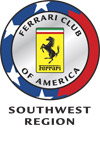


 legend has it
that is was the exploits of a certain stirling moss, racing in 1950 and 1951 with an hwm
formula 2 powered by an alta 4-cylinder engine against ferrari?s v-12 formula 2 cars,
that first alerted the folks at maranello to the beneficial characteristics inherent in
the 4-cylinder layout. as was customary at ferrari a promising innovation was to be tried
first in a monoposto race car, and by the end of 1951 ferrari had a 2-liter 4-cylinder
(i.e. 500cc per cylinder) formula 2 car ready. when formula 2 took formula1?s world
championship status for the 1952 season the 500 formula 2 ferrari was virtually
invincible, easily winning the championship.
legend has it
that is was the exploits of a certain stirling moss, racing in 1950 and 1951 with an hwm
formula 2 powered by an alta 4-cylinder engine against ferrari?s v-12 formula 2 cars,
that first alerted the folks at maranello to the beneficial characteristics inherent in
the 4-cylinder layout. as was customary at ferrari a promising innovation was to be tried
first in a monoposto race car, and by the end of 1951 ferrari had a 2-liter 4-cylinder
(i.e. 500cc per cylinder) formula 2 car ready. when formula 2 took formula1?s world
championship status for the 1952 season the 500 formula 2 ferrari was virtually
invincible, easily winning the championship.